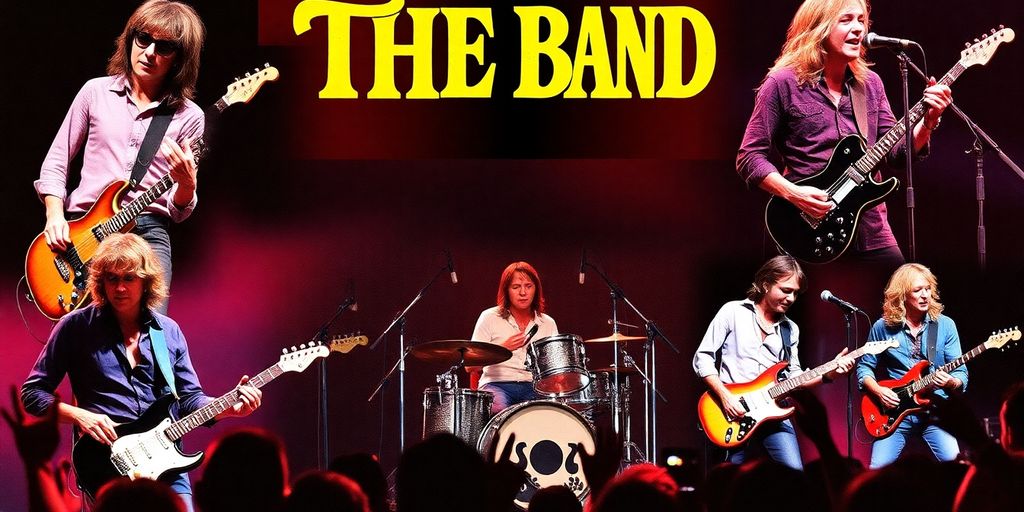
The music group The Band has left a lasting mark on the landscape of rock music. Known for their unique blend of rock, folk, and American roots music, they rose to fame in the late 1960s and early 1970s. Their collaboration with Bob Dylan and a series of iconic albums solidified their place in music history. This article explores their origins, hit songs, and the cultural impact they have had over the years, highlighting why they continue to influence artists today.
Key Takeaways
- The Band was formed in the 1960s and gained fame through their collaboration with Bob Dylan.
- Their albums, like ‘Music From Big Pink’ and ‘The Band’, defined their unique sound and style.
- Hits such as ‘The Weight’ and ‘I Shall Be Released’ remain popular and influential today.
- The Band’s music features a distinct fusion of genres, characterized by rich vocal harmonies and intricate instrumental arrangements.
- Their legacy includes a significant cultural impact, inspiring numerous artists and being celebrated in various documentaries and cover versions.
The Origins Of The Music Group The Band

The Band, a legendary group, holds a special place in music history. Their unique sound and collaborative spirit set them apart. Let’s explore how this iconic band came to be.
Formation and Early Years
The story of The Band begins not with a bang, but with a slow burn. The musicians who would eventually form The Band started out as sidemen, backing various artists before solidifying their own identity. Initially, they were known as The Hawks, supporting rockabilly star Ronnie Hawkins.
- The Hawks honed their skills playing long hours in clubs and bars across North America.
- This experience gave them a tight, cohesive sound and a deep understanding of various musical styles.
- The original lineup included Levon Helm, Robbie Robertson, Rick Danko, Richard Manuel, and Garth Hudson.
Collaboration with Bob Dylan
The Band’s association with Bob Dylan marked a turning point in their career. They became Dylan’s backing band during his controversial electric period in the mid-1960s. This collaboration exposed them to a wider audience and helped them develop their own unique musical voice. Their work together is now considered a pivotal moment in rock history. You can find more about Robbie Robertson and his work with Dylan online.
Working with Dylan was intense. It pushed them creatively and forced them to adapt to his unpredictable style. It was a trial by fire, but it ultimately shaped them into the band we know and love.
Influence of American Roots Music
One of the defining characteristics of The Band’s music is its deep connection to American roots music. They drew inspiration from a wide range of genres, including blues, country, gospel, and folk. This fusion of styles created a sound that was both familiar and innovative. Their music felt authentic and timeless, resonating with audiences of all ages. The Band’s discography includes seven albums from the original lineup.
- They incorporated traditional instruments like the mandolin and accordion into their arrangements.
- Their lyrics often told stories about American history and folklore.
- They celebrated the struggles and triumphs of ordinary people.
Iconic Albums That Defined Their Sound

The Band didn’t just release albums; they crafted sonic landscapes that continue to influence musicians today. Their discography is a journey through American roots music, blending rock, folk, country, and blues into something uniquely their own. Let’s take a look at some of the albums that cemented their place in music history.
Music From Big Pink
Music From Big Pink wasn’t just an album; it was a statement. Released in 1968, it arrived at a time when psychedelic rock dominated the airwaves. The Band offered something different: a raw, honest sound rooted in Americana. It’s an album that feels both timeless and deeply connected to a specific moment in music history. The album cover itself, painted by Bob Dylan, adds to the mystique.
- "Tears of Rage" – A collaboration with Bob Dylan, setting the tone for the album’s emotional depth.
- "The Weight" – Arguably their most famous song, exploring themes of burden and redemption.
- "Chest Fever" – A rollicking instrumental showcasing Garth Hudson’s organ skills.
Music From Big Pink is more than just a collection of songs; it’s an experience. The album’s loose, organic feel creates a sense of intimacy, as if you’re sitting in the room with the band as they play. It’s an album that rewards repeated listens, revealing new nuances with each spin.
The Band
Often referred to as The Brown Album, The Band (1969) solidified their reputation as masters of American roots music. This self-titled album is darker and more introspective than Big Pink, exploring themes of history, mythology, and the human condition. The songwriting is top-notch, and the performances are full of emotion. It’s an album that demands your attention and rewards careful listening. It’s one of the influential albums that shaped rock music.
- "The Night They Drove Old Dixie Down" – A controversial but powerful song about the Civil War from the perspective of a Confederate sympathizer.
- "Rag Mama Rag" – A lively, piano-driven tune showcasing their versatility.
- "King Harvest (Has Surely Come)" – A song about the struggles of farmers during the Great Depression.
Northern Lights – Southern Cross
Released in 1975, Northern Lights – Southern Cross marked a shift in The Band’s sound, incorporating more sophisticated arrangements and production techniques. While it may not be as iconic as their first two albums, it’s still a strong collection of songs that showcases their musical prowess. It’s an album that deserves a second look, offering a glimpse into the band’s evolution.
- "Ophelia" – A catchy, upbeat song with a New Orleans feel.
- "Acadian Driftwood" – A historical narrative about the expulsion of the Acadians from Canada.
- "It Makes No Difference" – A soulful ballad featuring Rick Danko’s emotional vocals.
Chart-Topping Hits That Resonate Today
The Weight
"The Weight" is probably The Band’s most famous song, and for good reason. It’s got that sing-along quality that makes it stick in your head for days. The song’s narrative, about a guy named Virgil and his journey, is super relatable, even if you’ve never been to Nazareth. It’s one of those tunes that just feels good to listen to, no matter what mood you’re in. It’s been covered by everyone from Aretha Franklin to Mumford & Sons, which just shows how timeless it is. You can still hear it on the radio all the time. It’s a classic for a reason.
I Shall Be Released
"I Shall Be Released" is a powerful ballad, originally written by Bob Dylan, but The Band’s version is what most people remember. It’s a song about hope and freedom, and it’s hard not to get chills when you hear it. The harmonies are amazing, and Levon Helm’s vocals are just perfect. It’s one of those songs that makes you think about the bigger things in life. It’s been used in movies and TV shows, and it’s still a favorite among musicians. It’s a song that speaks to the human spirit, and that’s why it still resonates today. It’s a song that’s been covered by many artists, including Nina Simone, each bringing their own unique interpretation to the Billboard Artist 100.
Up On Cripple Creek
"Up On Cripple Creek" is a fun, upbeat song that’s totally different from "The Weight" or "I Shall Be Released." It’s got that distinctive sound, thanks to the clavinette, and it’s just a great song to dance to. The lyrics are a bit quirky, but that’s part of its charm. It’s a song about having a good time, and it’s hard not to smile when you hear it. It’s been used in commercials and movies, and it’s still a popular choice for parties and events. It’s a song that’s guaranteed to get you moving, and that’s why it’s still a hit today.
The Band’s music is more than just a collection of songs; it’s a journey through American history and culture. Their ability to blend different genres and tell stories through their music is what makes them so special. They were able to capture the essence of the American experience in a way that few other bands have been able to do.
The Band’s Unique Musical Style
Their sound? Totally their own thing. It’s what made them stand out, even among all the other cool bands back then. They weren’t just playing music; they were mixing stuff up and creating something new. It’s hard to put your finger on exactly what it was, but you knew it when you heard it.
Fusion of Genres
The Band was awesome at mixing different kinds of music. They took rock, country, blues, and gospel, threw it all in a pot, and stirred it up. It wasn’t just one style or another; it was all of them at once. This is what made their music so interesting and different from what everyone else was doing. They really helped to shape roots rock group music as we know it.
Vocal Harmonies
Their vocals? Amazing. They weren’t just singing the same notes; they were blending their voices together in a way that gave you chills. Each member brought something different to the table, and when they sang together, it was pure magic. It’s one of the things that made their songs so memorable.
Instrumental Arrangements
Their instrumental arrangements were something else. It wasn’t just about playing the right notes; it was about creating a mood and telling a story. Garth Hudson’s organ playing was especially cool, adding this unique sound that you didn’t hear anywhere else. The way they used instruments was a big part of what made Robbie Robertson’s music so special.
The Band’s music felt like a conversation between instruments, each one adding its own voice to the story. It wasn’t just about showing off; it was about creating something bigger than themselves.
Here’s a quick look at some of the instruments they used:
- Organ
- Guitar
- Drums
- Piano
- Mandolin
Cultural Impact and Legacy
The Band’s music didn’t just fade away after they stopped touring. It’s still felt today, in ways you might not even realize. They weren’t just another group; they shaped how people thought about American roots music and what rock could be.
Influence on Rock Music
The Band’s impact on rock music is undeniable. They helped bring a focus back to storytelling in songs, and their blend of different genres paved the way for other artists to experiment. Their sound became a touchstone for musicians looking to create something authentic and lasting. You can hear echoes of their style in countless bands that came after them.
Documentaries and Biographies
There have been several attempts to capture The Band’s story on film and in books. These documentaries and biographies try to unpack the complexities of the group’s dynamics, their music, and their place in music history. They offer different perspectives, but they all point to the same conclusion: The Band was something special.
Tributes and Cover Versions
One of the clearest signs of a band’s lasting impact is how often their songs are covered by other artists. The Band’s music has been reinterpreted by musicians from all sorts of backgrounds, showing the timeless quality of their songwriting. It’s cool to hear how different artists put their own spin on classics like "The Weight" or "I Shall Be Released".
The Band’s influence isn’t just about the notes they played; it’s about the feeling they created. They tapped into something deep and real, and that’s why their music continues to connect with people across generations. It’s a reminder that music can be more than just entertainment; it can be a way to understand ourselves and the world around us.
Live Performances and Their Significance
The Band wasn’t just about studio albums; their live shows were legendary. They had a way of connecting with the audience that’s hard to describe, a raw energy that translated into unforgettable performances. It wasn’t just about playing the songs; it was about creating an experience.
The Last Waltz
"The Last Waltz" is probably the most famous concert film ever made. Directed by Martin Scorsese, it documented The Band’s farewell performance at the Winterland Ballroom in San Francisco on Thanksgiving Day, 1976. It wasn’t just a concert; it was a celebration of music and friendship.
- The guest list was insane: Bob Dylan, Eric Clapton, Joni Mitchell, Van Morrison, Neil Young, and more.
- Scorsese’s direction gave it a cinematic feel, unlike any concert film before it.
- It captured a moment in music history, the end of an era for The Band and a reflection on rock music itself.
The Last Waltz is more than just a concert film; it’s a cultural artifact. It represents a time when music felt bigger, more important, and more connected to the soul. It’s a reminder of the power of collaboration and the bittersweet beauty of endings.
Rock of Ages
Before "The Last Waltz," there was "Rock of Ages," The Band’s first official live album, recorded during their New Year’s Eve concerts in 1971 at the Academy of Music in New York City. It’s a different vibe than "The Last Waltz," more raw and energetic. The live album really shows off their musical chops.
- Features arrangements with horns by Allen Toussaint, adding a New Orleans flavor to their sound.
- Includes extended versions of their classic songs, showcasing their improvisational skills.
- Captures the energy of The Band at their peak, before the wear and tear of touring took its toll.
Memorable Concerts
Beyond the big, filmed events, The Band played countless shows that left a mark on those who were there. They were known for their tight performances and their ability to bring their studio sound to life on stage. They were a true rock band.
- Their performance at Watkins Glen in 1973, alongside the Grateful Dead and the Allman Brothers Band, drew over 600,000 people.
- Their early shows with Bob Dylan, though sometimes met with resistance from Dylan’s folk fans, were crucial in shaping their sound and stage presence.
- Their smaller, more intimate shows allowed them to connect with their fans on a deeper level, creating a sense of community around their music.
Here’s a table showing some of their notable performances:
| Concert | Year | Location |
|---|---|---|
| Watkins Glen Summer Jam | 1973 | Watkins Glen, NY |
| Academy of Music | 1971 | New York City, NY |
| Winterland Ballroom | 1976 | San Francisco, CA |
The Members’ Solo Careers
It’s interesting to see what happens when band members strike out on their own. Sometimes it works, sometimes it doesn’t. With The Band, each member had their own unique path after the group’s initial run. Some found success, while others explored different avenues.
Robbie Robertson’s Solo Work
Robbie Robertson definitely made a splash with his solo career. His self-titled debut album in 1987 was a big deal, especially since Daniel Lanois produced it. He even got U2 and Peter Gabriel involved, which is pretty cool. It felt like a real comeback for him. Before that, he was doing soundtrack work, but this album showed he still had a lot to say as a solo artist. It was a Top 40 hit, proving he could still craft atmospheric sounds.
Levon Helm’s Musical Journey
Levon Helm was always a busy guy, and his solo work reflected that. He put out a few albums, including "Levon Helm and the RCO All-Stars" in 1977. That one had a ton of guest musicians, like members of Booker T. and the MGs and Dr. John. He even had his own studio, RCO Studios, where he recorded it. He also did some acting, including a role in the Loretta Lynn biopic ‘Coal Miner’s Daughter’.
- "Levon Helm and the RCO All-Stars" (1977)
- "Levon Helm" (1982)
- "Dirt Farmer" (2007)
Helm’s solo work often showcased his deep connection to American roots music. He wasn’t just a drummer; he was a storyteller, and his albums often felt like a celebration of that tradition.
Rick Danko’s Contributions
Rick Danko also released solo material. His first solo album was his only full-length studio effort without collaborators. He also teamed up with Jonas Fjeld and Eric Andersen for the "Danko / Fjeld / Andersen" album, which is a cool mix of Canadian, Norwegian, and American musical styles. Plus, he toured with Ringo Starr’s All-Starr Band, which is a fun fact. He was featured on Ringo Starr’s first official live album, recorded under the All-Starr Band banner.
Wrapping It Up
In the end, The Band’s impact on music is hard to overstate. They blended rock, folk, and blues in a way that felt fresh and real. Their songs still hit home, touching on themes of life, love, and loss. Even decades later, tracks like "The Weight" and "Up on Cripple Creek" are still played everywhere, reminding us of their genius. Their story is one of creativity, collaboration, and a bit of chaos, which makes it all the more relatable. So whether you’re a longtime fan or just discovering their music, there’s a lot to appreciate. The Band may have hung up their instruments, but their legacy? It’s alive and well.
Frequently Asked Questions
What is the history behind The Band’s formation?
The Band was formed in the 1960s, originally as a backing group for Bob Dylan. They came together in Canada and blended different musical styles.
Which albums are considered The Band’s most important?
Some of their key albums include ‘Music From Big Pink,’ ‘The Band,’ and ‘Northern Lights – Southern Cross.’ These albums helped shape their unique sound.
What are some of The Band’s biggest hits?
Some of their most popular songs are ‘The Weight,’ ‘I Shall Be Released,’ and ‘Up On Cripple Creek.’ These tracks are still loved by many today.
How did The Band influence other musicians?
The Band influenced many rock musicians with their mix of rock, folk, and country music. They showed that songs could tell stories and connect with people.
What is the significance of their live performances?
The Band’s live shows, especially ‘The Last Waltz,’ are famous for capturing their energy and talent. These concerts have become a big part of their legacy.
What did the members of The Band do after they split up?
After The Band broke up, members like Robbie Robertson and Levon Helm had successful solo careers, creating music that continued to inspire fans.





